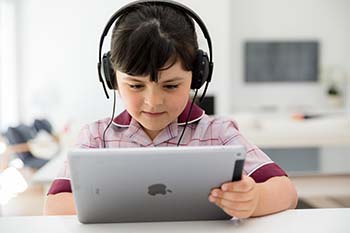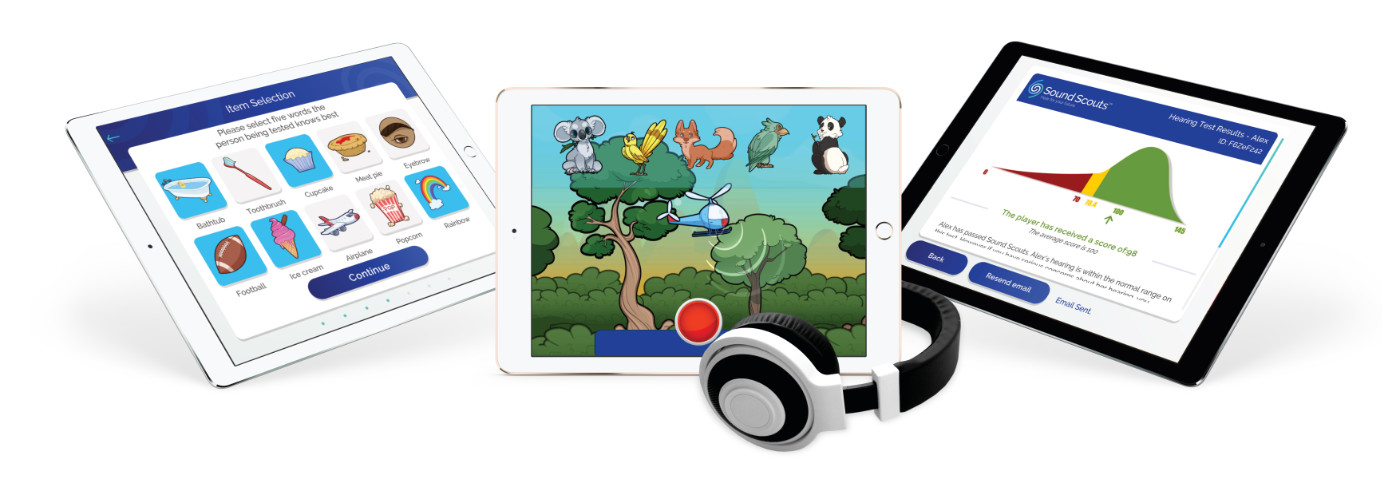Sound Scouts for Clinicians
Why Sound Scouts?
Provide Accessible Screening
that is reliable and escalates children to a full audiological exam when required.
Improve Referral Processes
by moving children along the correct referral pathway more quickly.
Access Results Securely
and Immediately In-Clinic through the Clinical Portal.
How Does it Work?
Sound Scouts Chief Scientist Professor Harvey Dillon explains how the game works:
“The Sound Scouts hearing game looks and feels like a game when it is played by a five-year old (or older) child on a mobile device. However, it incorporates several advanced scientific principles that enable it to detect a range of hearing problems...
The game comprises three interleaved tests of hearing; two based on perceiving speech - one in noise and one in quiet - and one based on perceiving tones against a noise background. Each of these constantly adapts so that the child is always listening at the edge of his or her hearing capability. Algorithms within the game check that the child is responding reliably, as well as measuring the child’s actual ability. The results from the three tests are combined to automatically display a test result as soon as the game is completed.”
A Trusted Solution

Sound Scouts has been developed in collaboration with the National Acoustic Laboratories, a world leader in hearing assessment and rehabilitation. It’s recommended and accepted as a referral by Hearing Australia and supported by NSW Health.
Sound Scouts incorporates the science of a hearing test in a fun, interactive game. Sound Scouts tests children for the three main types of hearing loss; sensorineural hearing loss, conductive hearing loss and listening difficulties in noise. Results are delivered securely and immediately in a report.
Applications of Sound Scouts in Clinics
Although the principal use of Sound Scouts is to detect previously undiagnosed hearing problems in school aged children, the test has other potential applications.
Post-treatment Monitoring
Following detection of significant conductive loss, there is a need to determine whether treatment (antibiotics or ear ventilation tubes) or watchful waiting have resulted in correction of the hearing loss. This is usually achieved by an audiologist assessing hearing by tympanometry or hearing thresholds, or by a medical practitioner otoscopically examining the eardrums. When access to a hearing health professional is not readily available Sound Scouts provides a convenient method by which hearing status after treatment can be monitored.
Sound Scouts can be utilised in a telehealth style capacity with the child playing the test remotely and the clinician able to log in to the Sound Scouts clinical portal to review the results.

Auditory Processing Disorder
It is known that protracted otitis media in early childhood strongly predisposes children to acquire spatial processing disorder (Cameron et al., 2014; Tomlin & Rance, 2014). Sound Scouts has been specifically designed to be sensitive to this condition, so its use after treatment for otitis media will likely also detect those children for whom otitis media has resulted in spatial processing disorder, for which separate remediation is needed, is already available, and is highly effective (Cameron et al., 2012). The test can be used for this purpose for any children over 4 years of age, which is considerably lower than is achievable by any other tests of auditory processing ability.
Potential Use by Hearing Professionals to Test for APD
ASHA (2005) and AAA (2010) urge caution in interpreting the results of auditory processing assessments in children under 7 years of age. Consequently, some clinicians choose not to perform auditory processing assessments on children until they are 7 years old. The Sound Scouts Triple Factor Hearing Screener includes a speech-in-spatialised-noise test that has normative data down to age 4.25 years. The test can therefore provide a clinician with information about each child’s ability to understand speech in noise, a critical ability that is impacted by an auditory processing disorder. Two advantages of the Triple Factor Hearing Screener are that the measurement is done within the context of an engaging game, which helps maintain engagement and motivation, and that the measurement can be done in any quiet location, supervised by a parent or teacher. The clinician can then access the detailed results via the Sound Scouts portal.
Register Your Interest
Clinicians can register for access to the Sound Scouts Clinical Portal. The Clinical Portal provides details of each patient’s test results. Clinicians can view the three components of the test - speech-in-quiet, speech-in-noise and tone-in-noise - along with other key test information. To register your interest please email contact@soundscouts.com.au.
